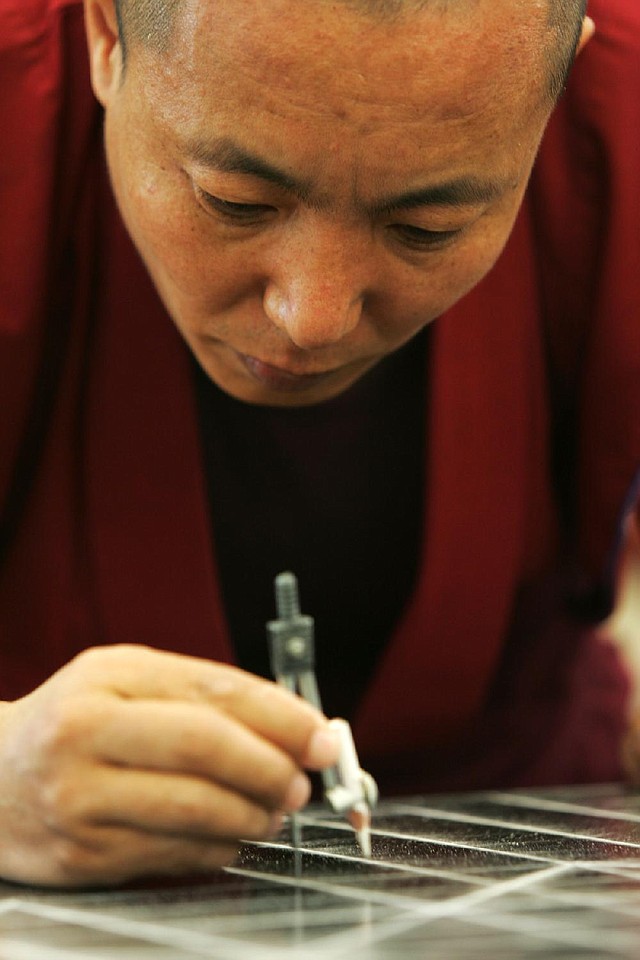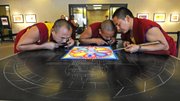Holy ground
Tibetan Buddhist monks to bless monument site
Namgyan Sangpo, a Tibetan monk, works on a mandala at the University of Arkansas at Fayetteville. Mandalas are intricate designs made of colored sand.
Saturday, March 9, 2013
Tibetan Buddhist monks from the Gyuto Tantric Monastery in India will participate in a groundbreaking ceremony today at the Land of Infinite Bliss Retreat Center in Madison County.
The center is an outreach of the Tibetan Cultural Institute of Arkansas. The monks will participate in several ceremonies including the groundbreaking, the consecration of a stupa, which is a religious monument, and a fire ceremony. The monks will also construct a sand mandala, a form of sacred art, starting Sunday at St. Paul’s Episcopal Church in Fayetteville.
The stupa will be a first for the Northwest Arkansas area and today’s groundbreaking ceremony is not the usual shovel into dirt photo opportunity. It’s a time to ask permission of the Earth to use the land, said Geshe Thupten Dorjee.
Dorjee, a Tibetan monk and instructor in the J.
William Fulbright College of Arts and Sciences at the University of Arkansas at Fayetteville, founded the institute as a way to teach others about the culture of Tibet and share his knowledge of Buddhist philosophy. He organized the monks’ visit to commemorate the second anniversary of the Dalai Lama’s visit to Fayetteville, and in memory of the more than 100 Tibetans who have practiced self-immolation to bring attention to their fight for religious freedom.
Geshe-la, as he is commonly called, is a native of Tibet. His family fled to India not long after Chinainvaded their home country in 1959. He entered the Drepung Loseling Monastery in India at the age of 13 and studied for 25 years, eventually earning the title geshe, which means spiritual teacher. He came to Arkansas in 2006 and has since become a naturalized U.S. citizen.
Dorjee said he hopes members of the community will attend the events to learn more about Tibetan culture.
A stupa is a common structure in Buddhist architecture that symbolizes the mind of the Buddha, Dorjee said. Stupas commonly include a domelike structure sitting upon a square, tiered platform. A spire rises from the dome and is topped with ornaments of a crescent moon and the sun. The stupa for the retreat center will be 16 feet tall.
“We build the stupa as a symbol of knowledge,” Dorjee said. “Every shape, every color is significant and it takes a lot of time to do it.”
After the groundbreaking, the monks will consecrate or bless various objects that will be placed in the stupa when it is built. Dorjee said the base of the stupa will be filled with treasure vases. The vases will be filled with semiprecious gems and stones, soil, water and minerals from around the world, including from Tibet and India, as well as from Arkansas.
Pages of sacred texts featuring mantras or prayers will be rolled up and placed inside the stupa, as well as tsa tsas, which are sacred images often placed in shrines.
Sidney Burris, professor in the Honors College at UA, helped start the institute with Dorjee. He said construction of the center isn’t complete, but the building is usable, with the interior remaining to be finished. He said the retreat center will be available for many uses.
“It will eventually be used for teachings by Tibetan masters of the tradition and then ultimately we hope to use it for individuals who would like to do meditation retreats,” Burris said. “We hope for summer programs for teenagers who want to learn some basic techniques of mental wellness.”
For Burris, Buddhism has been a lifelong interest.
“I was drawn to Asian philosophy since I was a kid for some reason and I saw the Dalai Lama in 1979 when he came on his first visit to the United States,” he said. “He gave a talk to our class on death and dying and I remember thinking that is one of the clearest expositions of death and dying I think I’ve ever heard.”
Burris said he wanted to know more and has been talking with Tibetan Buddhists ever since, trying to learn as much of their philosophical tradition as possible.
“It made sense to me from the beginning and it makes sense now,” he said.
Burris said that during his 27 years in Arkansas, he has seen a long-standing interest in Buddhism that has been growing recently.
“It’s not about being Buddhist so much,” he said. “I think a lot of people are interested in Buddhism because it brings a clarity of thought about their own lives and their own spiritual traditions that allows them sometimes to go back to their original tradition with renewed vigor and insight. That’s one of the reasons it has been popular.”
Burris said Buddhism isn’t a faith that seeks converts.
“It says, ‘This is what we think about how the mind works.’ You can take it or leave it. Its founding principles are based on logic and clarity of thought,” he said.
Dorjee said his classes at the university are full and his Sunday meditation and dharma classes have grown, too.
“Now we have 35 to 50 and it was two or three,” he said.
The groundbreaking ceremony and consecration for the stupa will be held at 2 p.m. today at the retreat center on Madison County Road 5520 near Crosses. A fire ritual ceremony will follow.
Construction of the sand mandala, a sacred form of art, will begin with an opening ceremony at 2 p.m. Sunday at St. Paul’s Episcopal Church, 224 N. East Ave. The monks will design a mandala featuring the deity Yamantaka, the conqueror of death, over the course of the week, using grains of colored sand to create an intricate picture. The public is welcome to watch the monks at work 9-11 a.m. and 2-5 p.m. Monday through March 16. A closing ceremony, in which the mandala will be destroyed, will be held at 5 p.m. March 17. The colored sand will be given to those present and a procession to Wilson Park will follow.There the sand will be tossed into the water.
A collection of Buddhist thangkas - religious paintings often done on silk - will be on display at the church, as well.
Information about the events and directions to the retreat center are available at artibet.com.
Religion, Pages 14 on 03/09/2013

